
Catalog excerpts

Dementia care Connected Care Solutions Key information for health, housing and social care professionals and carers
Open the catalog to page 1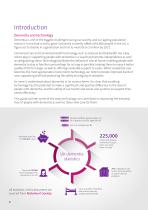
UK dementia statistics • Dementia affects approximately 1 in 14 of people in the UK aged over 65, and 1 in 6 people over 80 • 225,000 people will develop dementia this year, that’s one every three minutes • 70% of people in care homes have dementia or severe memory problems • Up to a quarter of hospital beds are taken up by people with dementia Dementia 670,000 carers of people with dementia in the UK • There are and technology Dementia is costs the UK £26.3bn a year facing our society, and our ageing population • Dementia one of the biggest challenges means it is one that is set to grow....
Open the catalog to page 2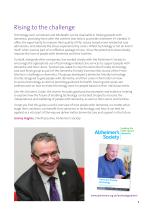
Rising to the challenge Technology such as telecare and telehealth can be invaluable in helping people with dementia, providing them with the comfort that help is accessible whenever it’s needed. It offers the opportunity to improve their quality of life, reduce hospital and residential care admissions, and alleviate the stress experienced by carers. Whilst technology is not an end in itself, when used as part of an effective package of care, it has the potential to dramatically improve the lives of people with dementia and their families. Tunstall, alongside other companies, has worked...
Open the catalog to page 3
What is Connected Care? Solutions are tailored to the needs of the individual and their circumstances, and designed to evolve over time as the user’s requirements change. Tunstall offers a range of Connected Care and Connected Health solutions, which use advanced technology underpinned by high quality, high touch services to provide enhanced care for older people and those with conditions such as dementia. Telecare forms part of Tunstall’s Connected Care solutions, and is a system of devices which support people in their own home by helping to manage risk. Appropriate, unobtrusive sensors...
Open the catalog to page 4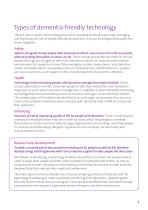
Types of dementia friendly technology There is now a wealth of technological solutions available aimed at supporting, managing and improving the lives of people affected by dementia. They can be categorised broadly into three categories: Safety Systems designed to help people with dementia and their carers live as full a life as possible, without putting themselves or others at risk. These include automated reminders to remind people not to go out at night on their own, and devices which can help to locate someone who becomes lost away from home. Other examples include smoke alarms, heat...
Open the catalog to page 5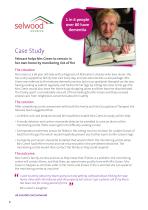
1 in 6 people over 80 have dementia Case Study Telecare helps Mrs Green to remain in her own home by monitoring risk of fire The situation Mrs Green is a 96 year old lady with a diagnosis of Alzheimer’s disease who lives alone. She has a very supportive family who visit every day, and she also receives a care package. Mrs Green was referred to the telecare dementia service by her occupational therapist as she was having cooking accidents regularly, and had burnt her legs by sitting too close to her gas fire. Mrs Green would also leave her home to go shopping alone and then become...
Open the catalog to page 6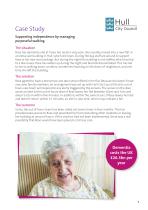
Case Study Supporting independence by managing purposeful walking The situation Rose has dementia and at times her recall is very poor. She recently moved into a new flat in an extra care building in Hull, which she loves. During the day staff are around to support Rose in her new surroundings. But during the night the building is not staffed, which has led to a few issues. Rose has woken up during the night and become disorientated. This has led to her to walking down corridors, sometimes knocking on the doors of neighbours, and one time she left the building. The solution Rose agreed to...
Open the catalog to page 7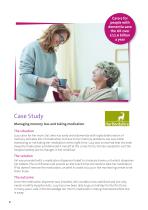
Carers for people with dementia save the UK over £11.6 billion a year Case Study Managing memory loss and taking medication The situation Lucy cares for her mum, Val, who has early onset dementia with rapid deterioration of memory. Val takes lots of medication, but due to her memory problems she was either overdosing or not taking her medication at the right time. Lucy was so worried that she took away the medication and delivered it herself at the correct time. Val also needed to visit the hospital weekly due to changes in her condition. The solution Val was provided with a medication...
Open the catalog to page 8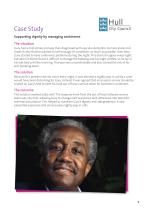
Case Study Supporting dignity by managing continence The situation Gary had a mild stroke and was then diagnosed with vascular dementia. He lives alone and made it clear that he wanted to selfmanage his conditions as much as possible. Over time, Gary started to have continence problems during the night. This did not happen every night, but when it did he found it difficult to change the bedding and his night clothes, so he lay in his wet bed until the morning. This was very uncomfortable and also carried the risk of his skin breaking down. The solution Because this problem did not occur...
Open the catalog to page 9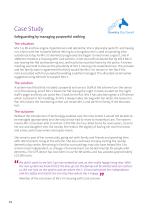
Case Study Safeguarding by managing purposeful walking The situation Mrs S is 89 and has angina, hypertension and dementia. She is physically quite fit, and having run a farm with her husband before retiring to a bungalow she is used to spending time outside each day. As Mrs S’s dementia progressed she began to need more support, and in 2008 she moved to a Housing with Care scheme, in her own self-contained flat. By 2013 Mrs S was leaving her flat and becoming lost, and had to be escorted home by the police. A review meeting was held to discuss the possibility of Mrs S moving into...
Open the catalog to page 10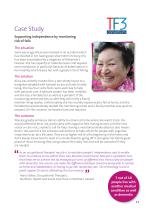
Case Study Supporting independence by monitoring risk of falls The situation Some years ago Alicia was involved in an accident which has resulted in her having poor short-term memory, this has been exacerbated by a diagnosis of Alzheimer’s Disease. She has capacity to make decisions and requires some assistance, in particular because of deterioration in her mobility which leaves her with a greater risk of falling. The solution Alicia has recently moved from a two-storey house to a bungalow adapted with ramped access and aids to daily living. She has four visits from carers each day to help...
Open the catalog to page 11All Tunstall catalogs and technical brochures
-
Ambient Temperature Sensor
2 Pages
-
Lifeline GSM
4 Pages
-
Smart Hub
6 Pages
-
Lifeline Vi and Vi+
8 Pages
-
Tunstall LifeCare
2 Pages
-
Innovations
23 Pages
-
Falls management
4 Pages
-
Total Housing Solutions brochure
16 Pages
-
Housing Services Portal
9 Pages
-
mymedic II
2 Pages
-
Bed Occupancy Sensor
2 Pages
-
Communicall Vi
8 Pages
-
iVi Intelligent Pendant
4 Pages
-
myclinic
4 Pages
-
Lifeline Vi
6 Pages
-
Portfolio Issue 25
48 Pages
-
CareAssist
2 Pages
-
Lifeline Vi
8 Pages






















